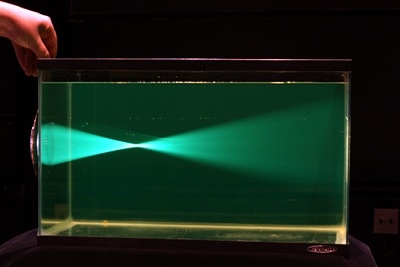A lens immersed in a fish tank of water seems to lose its refractive powers to focus light.

What it shows:
A lens seems to lose its ability to focus when immersed in water. This models the inability of us landlubbers to see clearly under water.
How it works:
Snell's law tells us that refraction depends, among other things, on the ratio of the indices of refraction of the incident and refracting media. The ratio for a glass lens in air is 1.5. When the lens is immersed in water, the ratio becomes 1.5/1.33 = 1.13, thus greatly diminishing the effect.
The lensmaker's formula


shows that the focal length becomes infinite as the ratio approaches 1. Indeed, a spherical Florence flask filled with water makes a very short focal length lens in air, but has no refracting power at all when immersed in water.
To show the effect, hold a short focal length lens (15 cm) outside an aquarium filled with water. One observes the parallel beam of light incident on the lens being focused inside the aquarium. When the same lens is immersed in the aquarium, the focal length more than doubles. A water-filled spherical flask inside the aquarium has no effect on the parallel beam of light.
Setting it up:
The photographs show a theater spotlight being used as the source of a parallel beam of light. A slide projector can also be used. Add a few drops of Fuorescine (or one drop of milk) to the water to make the beam visible. The overhead spotlights and blackboard lights should be turned down. No video projection is required.
Comments:
In the case of the human eye, two thirds of the refraction happens at the cornea/air interface. The index of refraction of the cornea is 1.376. When you try to see under water, n2/n1 = 1.035, and it's not surprising that humans have trouble focusing with a loss of 42 diopters in refractive power. See I.P. Herman for a detailed discussion.1 J.D. White and L.R. White wrote a nice piece worth reading entitled, "Underwater vision of dolphins and terns," in which they discuss how different animals (not just dolphins and terns) that need to see in and out of water have solved this problem without sporting diving masks.2
1 Irving Herman, Physics of the Human Body, (Springer, 2007), chapter 11 section 3.
2 James White and Laura White, Am J Phys 64(11), 1353-1354.